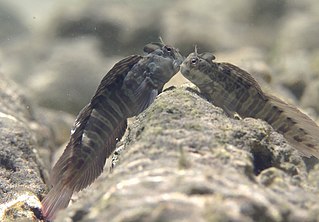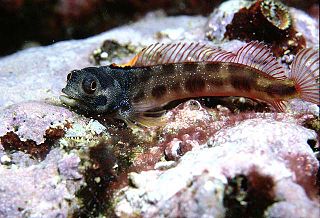
Istiblennius is a genus of combtooth blennies found in the Pacific and Indian Oceans. The generic name is a compound noun composed of istio the Greek for "sail", referring to the high dorsal fin of the type species, Istiblennius muelleri, and blennius which is derived from a word for "mucus" and refers to the scaleless bodies that characterise the Blenniidae.
Istiblennius colei is a species of combtooth blenny found in the western Pacific Ocean, around the Philippines. Males of this species can reach a maximum of 11.8 cm (4.6 in) SL, while females reach a maximum of 10.3 cm (4.1 in) SL. The specific name of this blenny honours Howard I. Cole (1892-1966) who was the Chief Chemist for the Philippine Health Service at the leper colony on Culion Island, Philippines, which is the type locality.

Istiblennius edentulus, the rippled rockskipper, is a species of combtooth blenny found in coral reefs in the Pacific and Indian Oceans. It is also commonly known as the rippled blenny, smooth-lipped blenny, toothless blenny, or coral blenny. Males of this species can reach a maximum of 16 cm (6.3 in) TL, while females can reach a maximum of 13.2 cm (5.2 in) SL.
Istiblennius flaviumbrinus is a species of combtooth blenny found in the western Indian Ocean, specifically the Red Sea. Males of this species can reach a maximum of 9 cm (3.5 in) SL, while females can reach a maximum of 7.2 cm (2.8 in) SL.

Istiblennius lineatus, the lined rockskipper, is a species of combtooth blenny found in coral reefs in the Pacific and Indian oceans. It is also commonly known as the lined blenny, black-lined blenny, or thin-lined rockskipper. It can reach a maximum of 15 cm (5.9 in) TL. This species can be found in the aquarium trade.

Istiblennius meleagris, the peacock rockskipper, is a species of combtooth blenny found in coral reefs in the western Pacific ocean. It is also known as the white-speckled blenny. Males can reach a maximum of 15 cm (5.9 in) TL, while females can reach a maximum of 10.6 cm (4.2 in) SL.
Istiblennius muelleri, Mueller's rockskipper, is a species of combtooth blenny found in the western Pacific ocean. Males of this species can reach a maximum of 7 cm (2.8 in) SL, while females can reach a maximum of 5.5 cm (2.2 in) SL. The specific zoology honours the German-Australian physician, geographer, and botanist Ferdinand von Mueller (1825-1896).
Istiblennius pox, the scarface rockskipper, is a species of combtooth blenny found in the western Indian Ocean. It can reach a maximum of 13 cm (5.1 in) TL.
Istiblennius rivulatus is a species of combtooth blenny found on coral reefs in the western Indian Ocean. Males of this species can reach a maximum of 8.6 cm (3.4 in) in standard length, while females can reach a maximum of 9.3 cm (3.7 in) in standard length.

Istiblennius spilotus, the spotted rockskipper, is a species of combtooth blenny found in the western Indian Ocean. Males of this species can reach a maximum of 14 cm (5.5 in) TL, while females can reach a maximum length of 9.7 cm (3.8 in) SL.
Istiblennius steindachneri is a species of combtooth blenny found in the western Indian Ocean. It can reach a maximum of 11 cm (4.3 in) in SL. The identity of the person honoured in this blenny's specific name was not stated by Pfeffer in his description but it is almost certainly the Austrian ichthyologist Franz Steindachner (1834-1919).

Istiblennius unicolor, the pallid rockskipper, is a species of combtooth blenny found on coral reefs in the western Indian Ocean. Males of this species can reach a maximum standard length of 10.2 cm (4.0 in), while females can reach a maximum length of 9.2 cm (3.6 in).

Istiblennius zebra, Pāoʻo, the zebra blenny, is a species of combtooth blenny found in tide pools around the Hawaiian Islands. It is also commonly known as the zebra rockskipper, rockskipper, jumping jack or the gori.

Petroscirtes ancylodon, the Arabian fangblenny, is a species of combtooth blenny found in the western Indian Ocean, and since 1989 recorded on occasion in the Levantine waters of the Mediterranean Sea, a likely entry from the Suez Canal. Males of this species reach a length of 11.5 cm TL while females reach a maximum length of 7.9 cm SL.

Xiphasia setifer, the hairtail blenny or the snake blenny, is a species of combtooth blenny found in the western Pacific and Indian Oceans. This species reaches 53 cm (21 in) in SL and is the longest species of combtooth blenny. It can also be found in the aquarium trade.

Acanthemblemaria hastingsi, the Cortez barnacle blenny, is a species of chaenopsid blenny found in the Gulf of California, in the eastern Pacific Ocean. Males can reach a maximum length of 5.1 cm (2.0 in) SL, while females can reach a maximum length of 4 cm (1.6 in). The specific name honours the marine biologist Philip A. Hastings of the Scripps Institution of Oceanography.

Acanthemblemaria mangognatha, the Revillagigedo barnacle blenny or Revillagigedo barnacle, is a species of chaenopsid blenny endemic to the Revillagigedo Islands of Mexico, in the eastern central Pacific ocean. It can reach a maximum length of 3.1 cm (1.2 in) SL.

Acanthemblemaria paula, the dwarf spinyhead blenny, is a species of chaenopsid blenny found in coral reefs around Belize, in the western central Atlantic ocean. It can reach a maximum length of 1.8 cm (0.71 in) SL.
Emblemaria biocellata, the twospot blenny, is a species of chaenopsid blenny found in coral reefs around Venezuela, French Guiana, and Colombia, in the western Atlantic Ocean. Males of this species can reach a maximum length of 3.8 centimetres (1.5 in) TL, while females can reach a maximum length of 4.1 centimetres (1.6 in) SL.
Emblemariopsis occidentalis, the flagfin blenny, blackfin blenny or redspine blenny, is a species of chaenopsid blenny found around the Bahamas, Brazil, and the Lesser Antilles, in the western Atlantic ocean. Males of this species can reach a maximum length of 1.9 centimetres (0.75 in) SL, while females can reach a maximum length of 1.7 centimetres (0.67 in).












